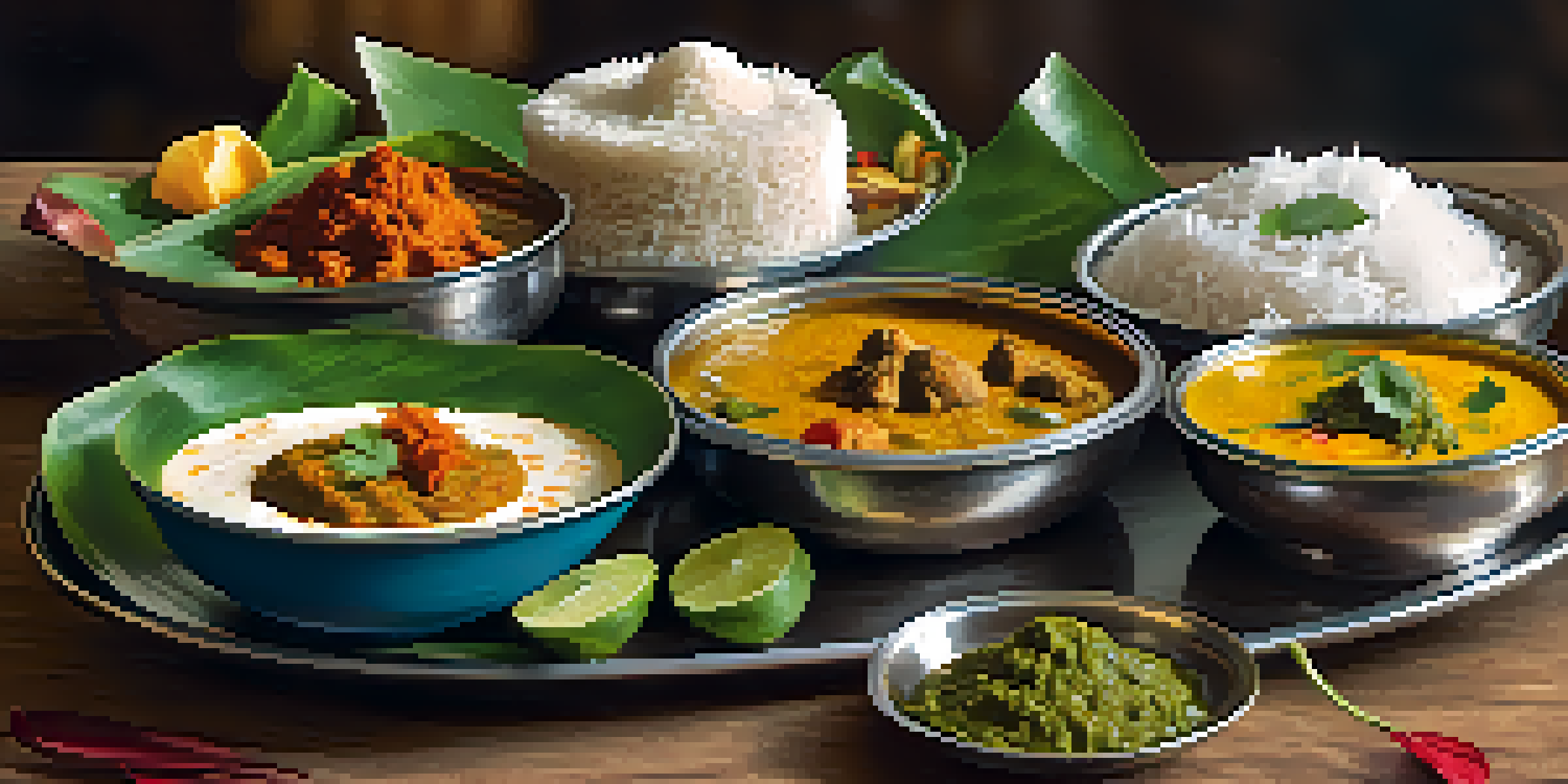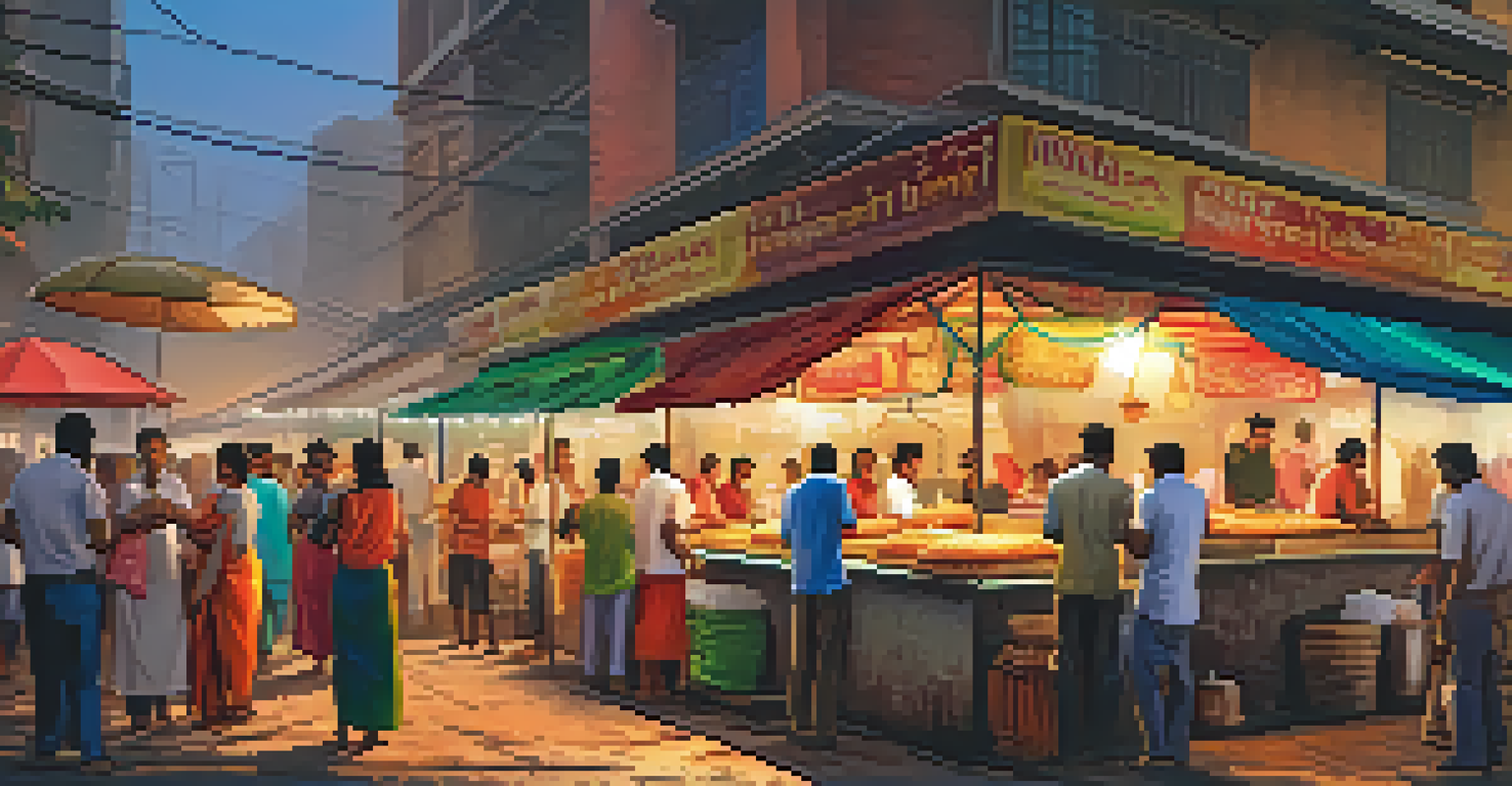Regional Flavors: A Deep Dive into India's Culinary Diversity

The North: A Melting Pot of Flavors and Influences
Northern India is famous for its rich and hearty dishes, often influenced by Mughal cuisine. Think of buttery naan and aromatic biryanis that tantalize your taste buds. The use of spices like cumin, coriander, and garam masala creates a symphony of flavors that reflect the region's history and culture.
Food is the ingredient that binds us together.
Each state brings its unique touch; for example, Punjab is renowned for its dairy dishes like paneer and lassi, while the Kashmiri cuisine features saffron-infused delights. These regional variations highlight how geography and climate shape the culinary landscape.
The warmth and hospitality of the North also play a role in its food culture, with communal dining being a cherished tradition. Sharing a meal together not only fosters connections but also emphasizes the vibrant tapestry of flavors that define Northern India.
The South: Spice and Coconut in Harmony
In stark contrast, Southern India is a haven for spice lovers, where dishes are often more fiery and coconut-based. From the tangy rasam of Tamil Nadu to the creamy curries of Kerala, every bite is a burst of flavor. The use of curry leaves, mustard seeds, and fresh coconut adds depth and richness to the cuisine.

Rice is a staple here, often served with a variety of side dishes that create a balanced meal. The thali, a platter filled with small servings of different dishes, is a perfect example of how diverse and satisfying Southern meals can be.
Diverse Flavors Across India
Each region of India boasts unique culinary traditions shaped by local ingredients, culture, and history.
The coastal areas also bring in an abundance of seafood, enhancing the variety of flavors available. Whether it's the spicy fish curry or the delicate prawn masala, Southern cuisine reflects a deep connection to the land and sea, making it truly unique.
The East: A Sweet and Savory Balance
Eastern India, particularly West Bengal, is known for its exquisite balance of sweet and savory dishes. The use of mustard oil and poppy seeds creates a distinctive flavor profile that sets it apart. Dishes like shorshe ilish, which features hilsa fish in mustard sauce, are iconic and beloved.
Eating is a necessity, but cooking is an art.
Sweets are also a significant part of Eastern cuisine, with treats like rasgulla and sandesh often stealing the spotlight. Festivals are a great time to indulge in these sweet delights, showcasing the region’s culinary diversity and creativity.
The influence of neighboring countries, like Bangladesh, adds to the depth of flavors found in Eastern dishes. The blend of cultural practices and ingredient availability makes this region a paradise for food enthusiasts.
The West: A Fusion of Flavors and Techniques
Western India boasts a vibrant culinary scene that varies dramatically from state to state. From the spicy curries of Gujarat to the seafood delicacies of Maharashtra, the region is a true fusion of flavors. Dishes like dhokla and pav bhaji are not only popular but also showcase local ingredients and cooking techniques.
The use of jaggery, a traditional sweetener, is prevalent in many Western dishes, lending a unique sweetness that balances spicy flavors. Additionally, the emphasis on vegetarian cuisine in Gujarat highlights the region's cultural and religious influences.
Street Food: A Cultural Staple
Street food reflects the heart of Indian cuisine, offering affordable, authentic flavors that connect communities.
Street food is a significant part of Western Indian cuisine, making it accessible and loved by all. Whether it’s the savory vada pav or the sweet puran poli, these dishes reflect the bustling energy and creativity of the region.
The Northeast: Culinary Traditions in Nature
The Northeastern states of India offer a culinary experience that is often overlooked but incredibly rich. With a focus on fresh herbs, greens, and meats, dishes are typically lighter and reflect the region's lush landscapes. Ingredients like bamboo shoots and fermented foods are common, adding unique flavors to traditional meals.
Each state has its own specialties; for instance, Assam is known for its rice dishes, while Nagaland is famous for its smoked meats and spicy chutneys. This variety showcases how local resources influence culinary practices.
A communal spirit is also prevalent, where meals are often enjoyed together, fostering a sense of unity. The emphasis on seasonal and locally sourced ingredients makes Northeastern cuisine both sustainable and deeply connected to the land.
Street Food: The Heartbeat of Indian Culinary Culture
One cannot talk about Indian cuisine without mentioning the vibrant street food scene. From spicy chaat in Delhi to steaming idlis in Chennai, street food encapsulates the essence of local flavors. It’s an affordable way to experience authentic dishes enjoyed by people from all walks of life.
Each region has its own specialties that reflect its culinary heritage. For example, Mumbai's vada pav and Kolkata’s puchka are not just snacks; they are cultural icons that tell a story of the people and traditions behind them.
Festivals Enhance Culinary Traditions
Indian festivals celebrate culinary heritage through traditional dishes that bring families together and evoke nostalgia.
Street food also encourages innovation, with vendors constantly experimenting and adding their unique twist to classic recipes. This ever-evolving culinary landscape is a testament to India’s dynamic food culture, making it an exciting adventure for food lovers.
Festivals and Food: Celebrating Culinary Heritage
Food plays a central role in Indian festivals, where culinary traditions come alive in vibrant celebrations. Each festival, from Diwali to Eid, features specific dishes that hold cultural significance and evoke nostalgia. It’s a time when families gather to prepare, share, and enjoy food together, reinforcing bonds and traditions.
For example, during Pongal, the South Indian harvest festival, families prepare a special rice dish dedicated to the Sun God. Similarly, during Holi, colorful sweets and snacks take center stage, symbolizing joy and togetherness.

These culinary traditions not only highlight the diversity of Indian cuisine but also reflect the values and stories passed down through generations. Festivals offer a unique opportunity to experience the rich tapestry of flavors that define India’s culinary heritage.